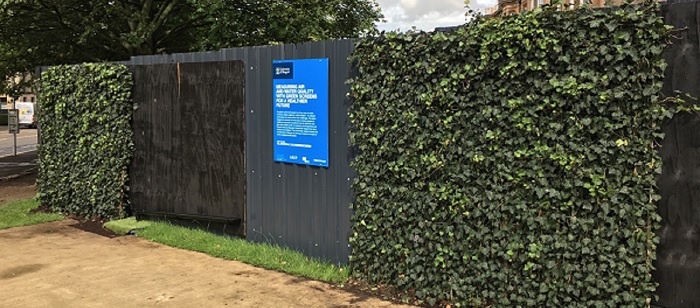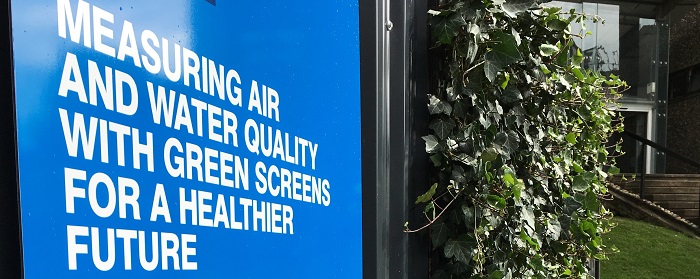Living Laboratories on campus
Published: 27 October 2021
The green screen trial in front of the Boyd Orr building on University Avenue is an example of the 'living laboratory' concept and forms part of a wider University initiative: the 'smart campus'.
Large infrastructure projects at universities present a great opportunity to test and research new ideas to improve the environmental and social impacts of the construction process that can be readily tested in a University context and then applied more widely in the future.
In this way, the campus development programme can be seen as a “living laboratory”. The green screen trial in front of the Boyd Orr building on University Avenue is one example of the living laboratory concept and forms part of a wider University initiative called the “smart campus”.
This is a collaborative project between the School of Geography and Earth Sciences, the School of Engineering, Multiplex and Mobilane, with funding supplied by Arup and the Engineering and Physical Sciences Research Council.
The green screen trial

What are green screens?
Green screens are fences made of ivy hanging on a wire mesh frame which can be used to green very urban parts of our city. They are an alternative to conventional wooden construction hoardings - an experimental ‘control’ - which are used to curtain off and restrict access to construction sites. Comprised of ivy wrapped around a simple mesh, these green screens represent a chance to install greenery throughout the urban landscape.
Why research green screens?
Less is known about how well green screens perform compared with better known urban greening solutions such as green roofs. Our research aims to help improve our understanding of these systems and the multifunctional benefits they may provide to society.
How may the green screens be of value to the local and wider community?
Due to urban population increase and the impacts of climate change, cities face mounting environmental pressures. Increasingly unstable weather systems are causing flooding, whilst harmful pollutants from vehicles are responsible for a vast range of health issues, some very serious. Green screens may help to alleviate these threats.
Results from recent studies in London and Birmingham have shown that screens can trap traffic-derived particulate matter and reduce other dangerous pollutants immediately behind the screens (see further information below). No similar research or data exists in Scotland and our research will address this gap.
How can green screens help?
Leaves intercept and imbibe rainwater before it hits the ground, slowing down the rate at which water enters drains. Some water also simply evaporates from the surface of leaves so less and slower runoff enters the sewer system, thus reducing the risk of urban flooding. At the same time, tiny hairs, grooves and wax on the surface of the leaves capture the microscopic pollutants produced by vehicles and prevent them from being inhaled.
The Experiment
This experiment aims to quantify the water and air pollutant capture by the green screens and compare them to two controls: 1) conventional wooden panels and 2) green screens in a nearby lower pollution setting. This will allow us to establish how much of a benefit these screens may be able to provide; this evidence will inform whether these types of greening systems should be established in urban areas all over the world.
Social Dimension
Green screens have the potential to improve the aesthetic value of grey urban areas and thereby improve both people’s mental health and their quality of life. Additional student projects will address this question alongside the main scientific experiment. We would welcome your involvement by participating in this social science research.
Wider University and community benefits

This research forms part of a series of research council (NERC and EPSRC) funded projects, led by the Schools of Engineering and Geographical and Earth Sciences, that are working with businesses and government agencies in Glasgow, across Scotland and the UK to facilitate enterprise.
This partnership research shows how the University of Glasgow is working with the city and its people to improve the health of urban ecosystems and people. The trial is the first of its kind in Scotland - and the first known globally - to look at rainfall attenuation benefits, helping the University and partners in Climate Ready Clyde test ideas to improve resilience to climate change. The green screen trial thus shows how research partnerships between the University’s estates department and academics can help the University deliver their Public Sector Reporting Duties on Climate Change more efficiently.
The social research planned as part of the research trial will allow staff, members of the public and community groups to share their thoughts on the green screen trial.
It is funded by the Engineering and Physical Sciences Research Council with support from Arup, Mobilane and Multiplex. This partnership research shows how the University of Glasgow is working to improve the health of urban ecosystems and people.
First published: 27 October 2021
<< News

